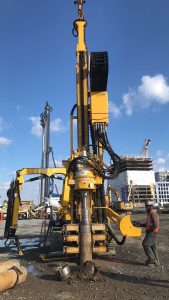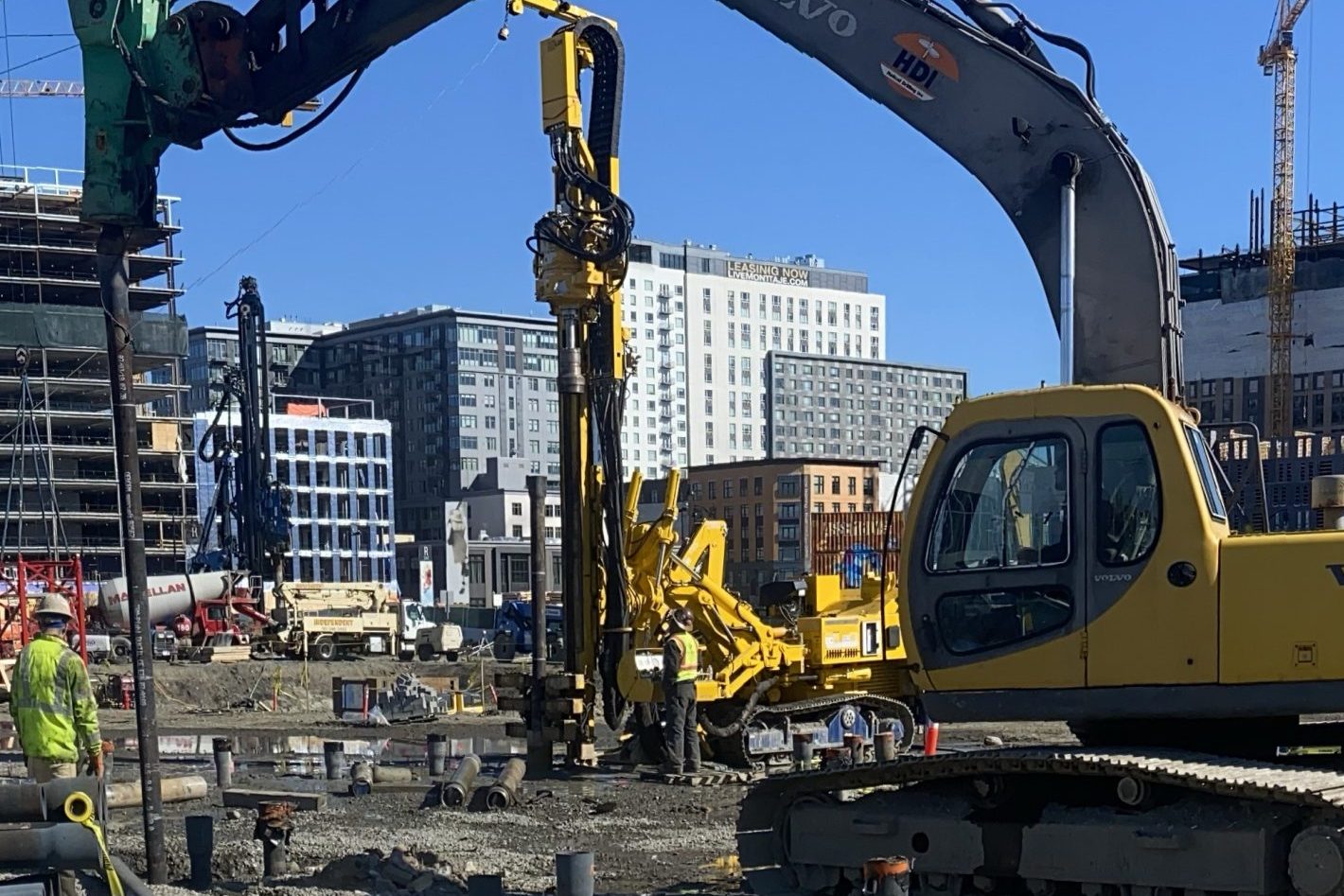Ductile Iron Piles Save Over $800,000 and 2-3 Months On Schedule at Assembly Row in Somerville, MA
Introduction:
Construction consisted of a new 8-story mixed use development in the Assembly Square District. The 63,000 sq ft footprint included column loads on the order of 200 to 1,000 kips. Loads at mat foundations ranged from 1,900 to 4,300 kips.
Geotechnical Conditions:
Subsurface conditions across the site generally consisted of urban fill and organics/peat underlain by a very stiff marine clay crust (transitioning to very soft marine clay) underlain by glacial soils and finally bedrock. The fill in the southwestern portion of the site contained significant obstructions from a former structure including buried foundations, slabs, granite blocks and steel. The fill was up to 17 feet thick in this area followed by up to about 50 feet of marine clay and 10 feet of glacial till before encountering bedrock at depths around 70 to 80 feet below grade.
Geotechnical Design/Build Solutions:
The project geotechnical consultant recognized the potential to use Geopier® ground improvement to provide a cost-effective foundation system across the majority of the building footprint. However, the deep obstructed fill zone in the southwest building corner prevented the use of ground improvement. Initial alternatives considered included 1) removal and replacement followed by ground improvement or 2) micropiles. The removal and replacement option would require substantial shoring and result in expensive fill disposal costs. The micropile option would penetrate the obstructed fill but would be relatively slow and expensive to extend the piles into bedrock for capacity.
With recent successful Ductile Iron Pile experience on a neighboring downtown Boston project, the geotechnical consultant realized the potential cost and schedule savings associated with the system over micropiles. We worked together to develop a hybrid pre-drilling / Ductile Iron Pile solution to support foundations in the obstructed areas. The approach utilized a high-frequency Sonic Drill rig to predrill 12-inch diameter holes through the obstructed fill. Once drilled, the initial 16.4-foot-long Ductile Iron Pile section was lowered into the hole and a second section was added and advanced. The annular space around the pile was then filled with sand. Following completion of the Sonic pre-drilling, the Ductile Iron Piles were driven through the remainder of the clay, glacial soils and set on competent rock using an excavator and breaker hammer.
Load Testing:
 Helical installed a pre-production load test pile and four reaction piles. The load test pile featured a Series 170/9.0 Ductile Iron Pile section installed to achieve a set criteria of 1” of movement in 50 seconds to provide an 85 ton compression capacity. The test pile was advanced to rock at a depth of 78 feet. The test pile was instrumented with two telltales and three strain gauges to confirm load transfer with depth. The test was performed to 170 tons (200% of design load). Nearly elastic performance was noted in the pile with a deflection of 0.69 inch recorded at the design load of 85 tons and total deflection of 1.5 inches at 170 tons. The net deflection following rebound was only 0.15 inches. Results of strain gauge measurements showed approximately 130 kips dissipated along the 78-ft long pile shaft with over 200 kips transferred to the tip in end-bearing.
Helical installed a pre-production load test pile and four reaction piles. The load test pile featured a Series 170/9.0 Ductile Iron Pile section installed to achieve a set criteria of 1” of movement in 50 seconds to provide an 85 ton compression capacity. The test pile was advanced to rock at a depth of 78 feet. The test pile was instrumented with two telltales and three strain gauges to confirm load transfer with depth. The test was performed to 170 tons (200% of design load). Nearly elastic performance was noted in the pile with a deflection of 0.69 inch recorded at the design load of 85 tons and total deflection of 1.5 inches at 170 tons. The net deflection following rebound was only 0.15 inches. Results of strain gauge measurements showed approximately 130 kips dissipated along the 78-ft long pile shaft with over 200 kips transferred to the tip in end-bearing.
Pile Production:
Fill zones were highly variable with some areas featuring solid 15-ft sections of steel and concrete being removed. After about two weeks for completion of the Sonic predrilling work, a total of 61 Ductile Iron Piles were installed in only 5 working days – averaging over 800 feet per day. In comparison with the micropile option, the hybrid solution saved the project team between 2 and 3 months on the schedule and over $800,000.

